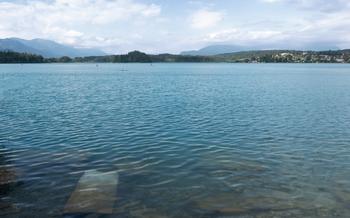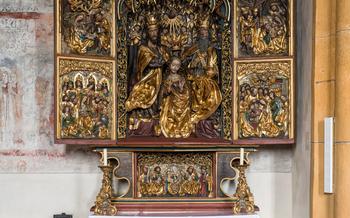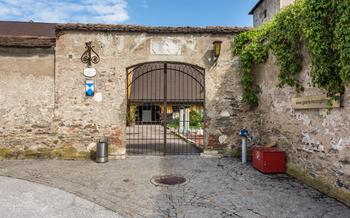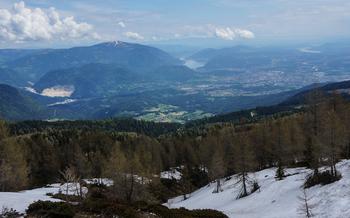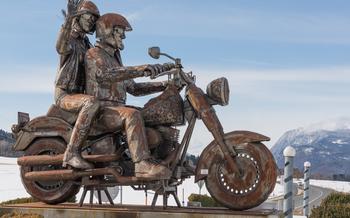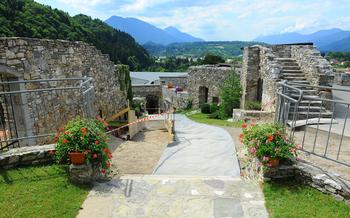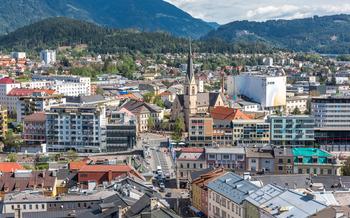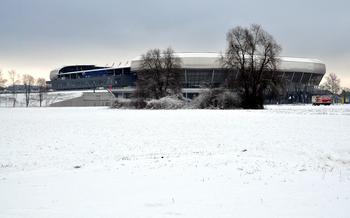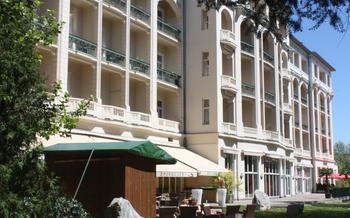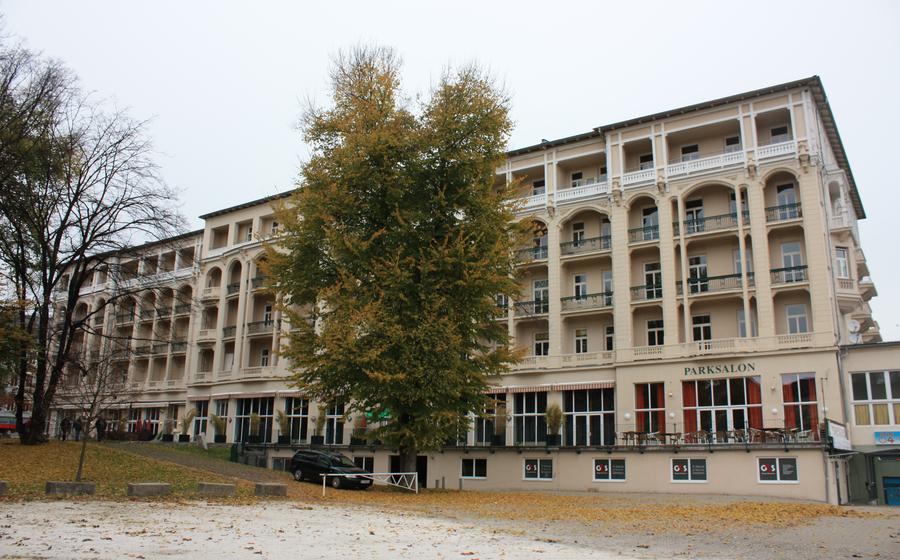
Drauboden Biotope
- The Drauboden Biotope: A Unique Natural Haven
- Exploring the Enchanting Landscape
- Observing Local Birdlife
- Popular Birdwatching Spots
- Notable Migratory Birds
- Tips for a Successful Birdwatching Experience
- Discovering the World of Reptiles and Amphibians:
- Exploring the Insect Life:
- Discovering Rare and Endangered Species
- Educational Opportunities:
- Family-Friendly Activities:
- Picnic Areas:
- A Walk Through History
- The Drau River
- Local Cuisine
- Local Crafts and Souvenirs
- Accommodation Options
- Insider Tips:
The Drauboden Biotope: A Unique Natural Haven
The Drauboden Biotope: A Haven for Biodiversity in Austria's Carinthia
Nestled in the heart of Carinthia, Austria, the Drauboden Biotope stands as a testament to the region's rich natural heritage. This unique and diverse ecosystem encompasses a vast network of wetlands, meadows, forests, and rivers, creating a haven for an extraordinary array of flora and fauna. The biotope's diverse habitats support a wide range of plant and animal life, making it a significant conservation area and a captivating destination for nature enthusiasts.
Key Characteristics of a Thriving Ecosystem:
-
Wetlands: The Drauboden Biotope is renowned for its extensive wetlands, which provide crucial habitats for various aquatic plants, amphibians, and waterbirds. These wetlands play a vital role in maintaining the ecological balance of the biotope, acting as natural filters and water storage areas.
-
Meadows: The biotope's lush meadows are a feast for the eyes, adorned with colorful wildflowers and grasses. These meadows are home to a diverse community of insects, butterflies, and birds, contributing to the vibrant tapestry of life within the biotope.
-
Forests: The Drauboden Biotope is home to a variety of forest ecosystems, ranging from deciduous to coniferous stands. These forests provide shelter and sustenance for numerous animal species, including deer, wild boar, and foxes.
-
Rivers: The Drau River, a lifeline of the region, meanders through the biotope, creating diverse aquatic habitats. This river supports a rich community of fish, aquatic insects, and waterfowl, adding to the biotope's biodiversity.
Abundance of Flora and Fauna:
The Drauboden Biotope is home to an astonishing array of plant and animal species. Over 800 plant species, including rare and endangered orchids, thrive within the biotope's diverse habitats. The biotope is also a haven for birdwatchers, with over 250 bird species recorded, including migratory species such as storks, cranes, and eagles. Additionally, the biotope's wetlands and forests are home to a variety of reptiles, amphibians, and mammals, contributing to its rich biodiversity.
Conservation Efforts to Protect the Biotope:
Recognizing the ecological significance of the Drauboden Biotope, significant efforts have been made to protect and conserve this natural treasure. The biotope has been designated as a Natura 2000 site, ensuring its protection under European Union law. Various conservation organizations, including the World Wildlife Fund (WWF), have implemented projects to restore and enhance the biotope's habitats. These efforts include wetland restoration, habitat management, and the reintroduction of endangered species, ensuring the long-term sustainability of this unique ecosystem.
Exploring the Enchanting Landscape
The Drauboden region offers a captivating landscape that invites visitors to immerse themselves in its natural beauty. The unique geography of the area, marked by rolling hills, lush meadows, and meandering rivers, provides a breathtaking backdrop for outdoor adventures.
Hikers can embark on scenic trails that wind through forests and along riverbanks, offering panoramic views of the surrounding countryside. The well-maintained paths cater to hikers of all levels, making it an accessible activity for families and individuals alike. Along the way, one can spot native wildflowers, observe local birdlife, and simply soak in the tranquility of the natural surroundings.
For those seeking a more leisurely experience, cycling routes meander through picturesque villages and along the Drau River. These trails provide a unique perspective of the region, allowing visitors to explore at their own pace and discover hidden gems off the beaten path.
Whether you prefer hiking, cycling, or simply relaxing in nature's embrace, the Drauboden region offers a multitude of opportunities to connect with the beauty of the outdoors.
Observing Local Birdlife
The Drauboden Biotope serves as a haven for a diverse array of bird species, attracting both local and migratory birds throughout the year. Birdwatching enthusiasts can embark on a journey through the biotope's varied habitats, from wetlands to woodlands, to witness the vibrant birdlife that calls this region home.
Popular Birdwatching Spots
The biotope offers a multitude of prime birdwatching spots, catering to the interests of both experienced and novice birdwatchers. The extensive network of trails and paths allows visitors to venture deep into the biotope's diverse ecosystems, while observation towers and hides provide elevated vantage points for spotting elusive species.
Notable Migratory Birds
One of the highlights of birdwatching in the Drauboden Biotope is the opportunity to observe a variety of migratory birds that pass through the region during their seasonal journeys. Birdwatchers can witness the graceful flight of storks and cranes, the vibrant colors of bee-eaters and rollers, and the soaring eagles that glide effortlessly above the landscape.
Tips for a Successful Birdwatching Experience
To enhance your birdwatching experience in the Drauboden Biotope, consider the following tips:
- Plan Your Visit: Choose the right time of year to visit, as different species migrate through the region at different times.
- Bring Binoculars: A good pair of binoculars is essential for spotting distant birds and observing their intricate details.
- Dress Appropriately: Wear comfortable clothing and sturdy footwear suitable for walking on uneven terrain.
- Be Patient and Quiet: Allow ample time for birdwatching and maintain a respectful silence to avoid disturbing the birds.
- Join a Guided Tour: Consider joining a guided birdwatching tour led by experienced local guides who can share their knowledge and help you identify different species.
Discovering the World of Reptiles and Amphibians:
The Drauboden Biotope serves as a sanctuary for a rich diversity of reptiles and amphibians, adding to the region's ecological richness. Among the notable reptile species found here are the agile lizard, the common wall lizard, and the grass snake. These creatures play a crucial role in the ecosystem, contributing to pest control and maintaining a balance in the food chain.
Amphibians, too, thrive within the biotope, with species such as the common frog, the alpine newt, and the fire-bellied toad calling this habitat their home. Their presence indicates the pristine water quality and intact habitats within the biotope. Visitors can often spot these amphibians basking in the sun or swimming in the shallow waters.
To enhance your wildlife viewing experience, it is essential to practice responsible observation techniques. Avoid disturbing the animals by maintaining a respectful distance and minimizing noise. Using binoculars or a telephoto lens for photography is recommended to capture images without causing distress to the wildlife. By following these guidelines, you can contribute to the preservation of this delicate ecosystem while enjoying the wonders of the Drauboden Biotope.
Exploring the Insect Life:
Insects play a crucial role in the delicate balance of the Drauboden Biotope's ecosystem. From the vibrant butterflies fluttering through the air to the intricate dragonflies darting over the water, these tiny creatures contribute significantly to the biotope's biodiversity.
Among the diverse insect species that thrive here, you might spot the striking cardinal red dragonfly, known for its impressive aerial acrobatics. The common blue butterfly, with its vivid azure wings, adds a touch of color to the landscape. Keep an eye out for the delicate damselflies, which dance gracefully near the water's edge.
Understanding the roles of these insects is essential. Butterflies and dragonflies, as pollinators, play a vital part in the reproduction of plants. They flit from flower to flower, transferring pollen and ensuring the continuation of plant life. Additionally, insects serve as a crucial food source for birds and other wildlife, contributing to the interconnectedness of the ecosystem.
It is crucial to practice responsible wildlife viewing to minimize any disturbance to these delicate creatures. Avoid sudden movements or loud noises, and always maintain a respectful distance. By observing insects from afar, you can appreciate their beauty and ecological significance without disrupting their natural behavior.
Discovering Rare and Endangered Species
Within the Drauboden Biotope, several rare and endangered species find refuge and thrive. The European pond turtle, with its distinctive yellow markings, is a critically endangered reptile that calls the biotope its home. The biotope also provides a habitat for the elusive European otter, a semi-aquatic mammal facing conservation challenges due to habitat loss and pollution. Furthermore, the critically endangered corncrake, a secretive bird with a distinctive call, finds refuge in the lush vegetation.
Understanding the conservation status of these species is crucial to preserving their populations. The European pond turtle faces threats such as habitat fragmentation, illegal pet trade, and road mortality. The European otter is vulnerable due to habitat degradation, pollution, and hunting. Conservation efforts focus on protecting their habitats, reducing human disturbances, and raising awareness about their plight.
To ensure the survival of these rare and endangered species, conservation initiatives are underway. These include habitat restoration projects, anti-poaching measures, and educational programs to raise awareness among local communities. By supporting these initiatives, visitors can contribute to the preservation of these unique and threatened species and help maintain the delicate balance of the Drauboden Biotope.
Educational Opportunities:
The Drauboden Biotope is not only a haven for wildlife but also a hub for learning and environmental education. A variety of guided nature tours and educational programs are offered throughout the year, catering to visitors of all ages and interests. These tours provide an immersive experience, allowing visitors to explore the biotope's diverse habitats, learn about its unique flora and fauna, and gain insights into the importance of conservation.
Workshops and seminars on local ecology are also conducted regularly, delving into specific aspects of the biotope's ecosystem. These sessions are led by experienced naturalists and ecologists who share their knowledge and expertise, providing participants with a deeper understanding of the intricate relationships between the biotope's various components.
Birdwatching and wildlife photography workshops are particularly popular, attracting enthusiasts from around the region. These workshops offer expert guidance on identifying and photographing the biotope's rich birdlife and other wildlife. Participants learn about bird behavior, migration patterns, and the techniques required to capture stunning images of these elusive creatures.
The biotope also provides excellent opportunities for students to conduct research projects. Whether it's studying the nesting habits of a particular bird species, analyzing water quality, or investigating the impact of climate change on local ecosystems, the biotope offers a wealth of research possibilities. Educational institutions often collaborate with local conservation organizations to facilitate student research projects, providing students with hands-on experience and valuable insights into the field of ecology.
Family-Friendly Activities:
The Drauboden Biotope offers a range of engaging activities designed to entertain and educate young visitors. Interactive nature trails and exhibits bring the wonders of the natural world to life, allowing children to explore and learn about the diverse flora and fauna that inhabit the biotope. Wildlife observation sessions specifically tailored for kids provide an opportunity to observe and appreciate the incredible creatures that call this unique habitat home. Additionally, workshops and activities focused on promoting environmental awareness instill a sense of responsibility and respect for the delicate balance of the ecosystem. Designated children's play areas offer a safe and fun space for kids to let loose and enjoy the outdoors, making the Drauboden Biotope an ideal destination for families seeking a memorable and educational experience.
Picnic Areas:
The Drauboden Biotope offers several designated picnic areas where you can enjoy a relaxing meal surrounded by nature's beauty. These spots are strategically located amidst the lush greenery, providing a tranquil ambiance for your picnic.
Picnic tables and benches are thoughtfully placed in these areas, ensuring a comfortable dining experience. You can spread out your blanket, unpack your basket filled with local delicacies, and relish the fresh air and serene surroundings.
Remember to follow responsible picnicking practices to protect the fragile ecosystem. Dispose of your waste properly in the designated bins and avoid leaving any trash behind. Respect the natural habitat by not disturbing the wildlife or damaging the plants.
Pack your picnic with sustainable choices, such as reusable containers and utensils, to minimize waste. By doing so, you contribute to preserving the pristine beauty of the Drauboden Biotope for future generations to enjoy.
A Walk Through History
The Drauboden region is steeped in a rich tapestry of history, with ancient ruins and archaeological sites scattered throughout the landscape. Immerse yourself in the region's past as you explore these historical gems. Uncover the secrets of the ancient Romans, who once occupied the area, and marvel at the remnants of their fortifications and settlements. Visit the ruins of medieval castles, where tales of knights and battles unfold. Delve into the history of the region's churches and monasteries, each holding unique stories of faith and devotion. As you wander through the Drauboden Biotope, let the whispers of the past guide your journey, connecting you to the vibrant heritage of this remarkable place.
The Drau River
The Drau River is a picturesque waterway that meanders through the Drauboden Biotope, offering a range of activities for visitors. Kayaking and canoeing enthusiasts can navigate the calm waters, enjoying the tranquil surroundings. Fishing enthusiasts can cast their lines and try their luck at catching local fish species. For those seeking relaxation, the riverbanks provide serene spots to unwind and soak in the beauty of the natural landscape.
Local Cuisine
While exploring the wonders of the Drauboden Biotope, take the opportunity to indulge in the region's culinary delights. The local cuisine of Villach and its surroundings offers a harmonious blend of traditional Austrian flavors and Mediterranean influences.
Sample regional delicacies such as "Kärntner Kasnudeln," a type of pasta filled with cheese and herbs, often served with browned butter and sauerkraut. "Kärntner Reindling," a sweet bread with cinnamon and raisins, is a must-try pastry. For a hearty meal, try "Kärntner Schnitzel," a breaded and fried cutlet, usually served with potato salad and lingonberries.
Incorporating local ingredients into your meals is a great way to support sustainable practices and savor the true flavors of the region. Visit local markets or farm shops to purchase fresh produce, cheese, and meats from local farmers. You can also find locally produced wines, beers, and spirits to complement your culinary journey.
Discover local restaurants and eateries that celebrate the region's culinary heritage. Many establishments offer dishes prepared with seasonal ingredients and traditional recipes, providing an authentic taste of Carinthian cuisine. Look for restaurants that display the "Kärnten Qualitätssiegel," a seal of approval for businesses that use regional products.
Indulging in the local cuisine of Villach is not only a delightful culinary experience but also a way to connect with the region's culture and traditions. Savor the flavors, embrace the hospitality, and create lasting memories through your gastronomic adventures.
Local Crafts and Souvenirs
As you explore the Drauboden Biotope, don't miss the opportunity to immerse yourself in the local culture through its vibrant crafts and souvenirs. Local artisans pour their hearts into creating unique pieces that reflect the region's essence, from intricately carved wooden sculptures to delicate hand-painted ceramics.
Discover hidden gems in local markets and shops, where you can find a treasure trove of handmade crafts. Pick up a hand-woven rug to add a touch of warmth to your home or select a one-of-a-kind piece of jewelry that will serve as a lasting reminder of your time in the Drauboden region.
By supporting the local craftspeople, you directly contribute to preserving traditional arts and crafts while ensuring that the rich cultural heritage of the region continues to thrive. These artisans are the custodians of ancient skills and techniques, and their creations are a testament to the region's unique identity.
As you browse the local shops and stalls, engage in conversations with the artisans to learn about their creative process and the stories behind their work. Each piece holds a special meaning and reflects the artisan's connection to the Drauboden Biotope and its surroundings.
Whether you're looking for a meaningful souvenir to cherish for years to come or a special gift for loved ones back home, the local crafts and souvenirs of the Drauboden region offer an authentic and memorable way to remember your visit.
Accommodation Options
For a comfortable stay near the Drauboden Biotope, you'll find a range of accommodation options to suit your needs and budget. Whether you prefer the convenience of a hotel, the cozy ambiance of a guesthouse, or the freedom of camping, there are options for every traveler.
If you seek a luxurious experience, consider booking a room at the renowned Hotel Schlosshotel Velden. Nestled amidst picturesque landscapes, this elegant hotel offers stunning views, world-class amenities, and easy access to the biotope.
For a more budget-friendly option, the Hotel Garni Pension Hubertus is a great choice. Situated just a short walk from the biotope, this charming hotel offers comfortable rooms, a delicious breakfast buffet, and friendly hospitality.
For those who prefer a more immersive experience, camping is an excellent option. Set up your tent at the nearby Campingplatz Drau, which offers well-maintained facilities, scenic pitches, and direct access to the Drau River.
To ensure a hassle-free stay, consider booking your accommodation in advance, especially during peak season when availability can be limited. Online platforms like Booking.com and Airbnb offer a wide range of options to choose from, allowing you to compare prices, amenities, and reviews before making a reservation.
Insider Tips:
-
Secret Wildlife Hideouts: Uncover hidden spots where wildlife sightings are almost guaranteed. Popular locations include the secluded ponds near the forest's edge and the reed beds by the riverbank.
-
Seasonal Wonders: Plan your visit during the spring or fall migration periods to witness a remarkable spectacle of birds in transit. For reptile enthusiasts, the warmer summer months provide the best opportunities for spotting sunbathing lizards and snakes.
-
Silent Observation: Patience and stillness are key to successful wildlife viewing. Avoid sudden movements or loud noises that might startle the animals. Use binoculars or a telephoto lens to observe them from a distance.
-
Local Guides: Tap into the knowledge of local guides who can lead you to the best spots and share insights about the biotope's wildlife. They can also help you identify and learn about the various species.
-
Leave No Trace: Respect the biotope's fragile ecosystem by leaving no trace of your visit. Pack out all your trash, and avoid disturbing the plants and animals. Your responsible behavior helps preserve this natural haven for future generations.
